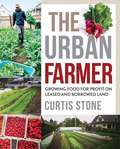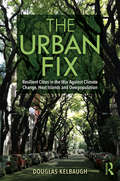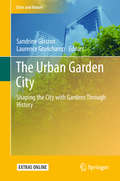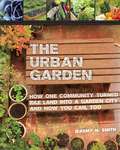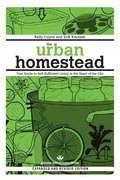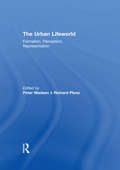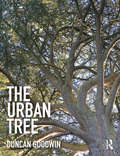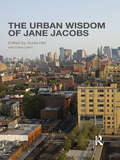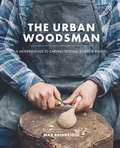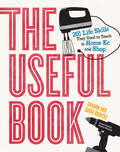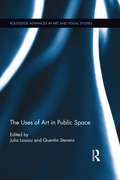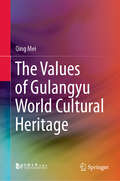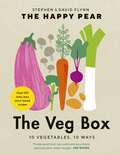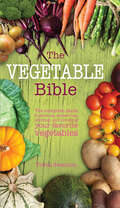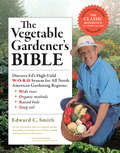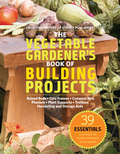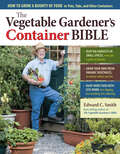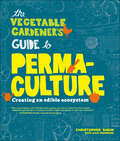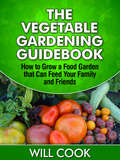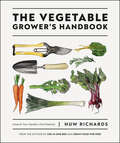- Table View
- List View
The Urban Farmer
by Curtis Allen StoneThere are twenty million acres of lawns in North America. In their current form, these unproductive expanses of grass represent a significant financial and environmental cost. However, viewed through a different lens, they can also be seen as a tremendous source of opportunity. Access to land is a major barrier for many people who want to enter the agricultural sector, and urban and suburban yards have huge potential for would-be farmers wanting to become part of this growing movement.The Urban Farmer is a comprehensive, hands-on, practical manual to help you learn the techniques and business strategies you need to make a good living growing high-yield, high-value crops right in your own backyard (or someone else's). Major benefits include: Low capital investment and overhead costs Reduced need for expensive infrastructure Easy access to marketsGrowing food in the city means that fresh crops may travel only a few blocks from field to table, making this innovative approach the next logical step in the local food movement. Based on a scalable, easily reproduced business model, The Urban Farmer is your complete guide to minimizing risk and maximizing profit by using intensive production in small leased or borrowed spaces.Curtis Stone is the owner/operator of Green City Acres, a commercial urban farm growing vegetables for farmers markets, restaurants, and retail outlets. During his slower months, Curtis works as a public speaker, teacher, and consultant, sharing his story to inspire a new generation of farmers.
The Urban Fix: Resilient Cities in the War Against Climate Change, Heat Islands and Overpopulation
by Douglas KelbaughCities are one of the most significant contributors to global climate change. The rapid speed at which urban centers use large amounts of resources adds to the global crisis and can lead to extreme local heat. The Urban Fix addresses how urban design, planning and policies can counter the threats of climate change, urban heat islands and overpopulation, helping cities take full advantage of their inherent advantages and new technologies to catalyze social, cultural and physical solutions to combat the epic, unprecedented challenges humanity faces. The book fills a conspicuous void in the international dialogue on climate change and heat islands by examining both the environmental benefits in developed countries and the population benefit in developing countries. Urban heat islands can be addressed in incremental, manageable steps, such as planting trees and painting roofs white, which provide a more concrete and proactive sense of progress for policymakers and practitioners. This book is invaluable to anyone searching for a better understanding of the impact of resilient cities in the monumental and urgent fight against climate change, and provides the tools to do so.
The Urban Garden City: Shaping The City With Gardens Through History (Cities and Nature)
by Sandrine Glatron Laurence GranchampThis book provides an interdisciplinary overview of the role of gardens in cities throughout different historical periods. It shows that, thanks to various forms of spatial and social organisation, gardens are part of the material urban landscape, biodiversity, symbolic and social shape, and assets of our cities, and are increasingly becoming valued as an ‘order’ to follow. Gardens have long been part of the development of cities, serving different purposes through the ages: shaping neighborhoods to promote health or hygiene, introducing aesthetic or biological elements, gathering the citizens around a social purpose, and providing food and diversity in times of crisis. Highlighting examples that can serve as the basis for comparisons, the chapters offer a brief panorama of experiences and models of gardens in the city – in the European context and in various periods of history – while also discussing issues related to garden cities, urban agriculture and community gardens. The contributors are university staff from various disciplines in the human and life sciences, in discourse with other academics but also with practitioners who are interested in experiences with urban gardens and in promoting an awareness of their spatial, social and ‘philosophical’ goals throughout history. The book will appeal to urban geographers, sociologists and historians, but also to urban ecologists dealing with ecosystem services, biodiversity and sustainable development in cities. From a more operational standpoint, landscape planners and architects are sure to find many of the projects enlightening and inspirational.
The Urban Garden: How One Community Turned Idle Land into a Garden City and How You Can, Too
by Bill Mckibben Chad Harder Sepp Jannotta Jeremy N. SmithFifteen people-plus a class of first graders-tell how local food, farms, and gardens changed their lives and their community...and how they can change yours, too.Urban Farming Handbook includes: Fifteen first-person stories of personal and civic transformation from a range of individuals, including farmers and community garden members, a low-income senior and troubled teen, a foodie, a food bank officer, and many more Seven in-depth "How It Works" sections on student farms, community gardens, community supported agriculture (CSA), community education, farm work therapy, community outreach, and more Detailed information on dozens of additional resources from relevant books and websites to government programs and national non-profit organizations Over 80 full-color photographs showing a diverse local food community at home, work, and playRead Urban Farming Handbook to: Learn how people like you, with busy lives like yours, can and do enjoy the many benefits of local food without having to become full-time organic farmers Gain the information you need to organize or get involved in your own "growing community" anywhere across the country and around the world.
The Urban Homestead (Expanded & Revised Edition)
by Kelly Coyne Erik KnutzenThe expanded, updated version of the best-selling classic, with a dozen new projects."A delightfully readable and very useful guide to front- and back-yard vegetable gardening, food foraging, food preserving, chicken keeping, and other useful skills for anyone interested in taking a more active role in growing and preparing the food they eat."-BoingBoing.net"...the contemporary bible on the subject."-The New York TimesThis celebrated, essential handbook shows how to grow and preserve your own food, clean your house without toxins, raise chickens, gain energy independence, and more. Step-by-step projects, tips, and anecdotes will help get you started homesteading immediately. The Urban Homestead is also a guidebook to the larger movement and will point you to the best books and Internet resources on self-sufficiency topics.Written by city dwellers for city dwellers, this copiously illustrated, two-color instruction book proposes a paradigm shift that will improve our lives, our community, and our planet. By growing our own food and harnessing natural energy, we are planting seeds for the future of our cities.Learn how to:Grow food on a patio or balconyPreserve or ferment food and make yogurt and cheeseCompost with wormsKeep city chickensDivert your grey water to your gardenClean your house without toxinsGuerilla garden in public spacesCreate the modern homestead of your dreams
The Urban Lifeworld: Formation Perception Representation
by Peter Madsen Richard PlunzUrban conditions are crucial to our experience of modernity, and, as reflected by art, literature and popular culture, have influenced contemporary ideas of what urban life is about.The Urban Lifeworld contributes to our understanding of the cultural role of cities by offering new insight into the analysis of urban experience. Two exceptional cities, New York and Copenhagen, are the focus of this exploration of cultural representations of urban life, which investigates the contrasts between perceptions and formation of the urban lifeworld.Integrating sociological, aesthetic and anthropological approaches to urban questions, this collection of essays presents a new vision of the cityscape which will enrich both academic debate and public life.
The Urban Section: An analytical tool for cities and streets
by Robert ManthoThe design of streets, and the connections between streets of different character, is the most important task for architects and urbanists working in an urban context. Considered at two distinct spatial scales – that of the individual street – the Street Section – and the complex of city streets – the City Transect – Urban Section identifies a range of generic street types and their success or otherwise in responding to climatic, cultural, traditional, morphological, social and economic well being. Using comparative studies a profile of best practice in street and city design is identified, showing methodologies in both the analysis of, and design for, successful streets and public places – place-making. In uniquely dealing with both the historic and contemporary description and analysis of urban ‘streets’ around the world, the work is of both academic and professional interest to architects, urban planners and designers, highway engineers, landscape and urban design advisers in both the public and private sectors; students, amenity and civic societies, city authorities and government agencies.
The Urban Tree
by Duncan GoodwinThere is a growing evidence base that documents the social, environmental and economic benefits that urban trees can deliver. Trees are, however, under threat today as never before due to competition for space imposed by development, other hard infrastructures, increased pressure on the availability of financial provision from local authorities and a highly cautious approach to risk management in a modern litigious society. It is, therefore, incumbent upon all of us in construction and urban design disciplines to pursue a set of goals that not only preserve existing trees where we can, but also ensure that new plantings are appropriately specified and detailed to enable their successful establishment and growth to productive maturity. Aimed at developers, urban planners, urban designers, landscape architects and arboriculturists, this book takes a candid look at the benefits that trees provide alongside the threats that are eliminating them from our towns and cities. It takes a simple, applied approach that explores a combination of science and practical experience to help ensure a pragmatic and reasoned approach to decision-making in terms of tree selection, specification, placement and establishment. In this way, trees can successfully be incorporated within our urban landscapes, so that we can continue to reap the benefits they provide.
The Urban Wisdom of Jane Jacobs (Planning, History and Environment Series)
by Sonia Hirt Diane ZahmHere for the first time is a thoroughly interdisciplinary and international examination of Jane Jacobs’s legacy. Divided into four parts: I. Jacobs, Urban Philosopher; II. Jacobs, Urban Economist; II. Jacobs, Urban Sociologist; and IV. Jacobs, Urban Designer, the book evaluates the impact of Jacobs’s writings and activism on the city, the professions dedicated to city-building and, more generally, on human thought. Together, the editors and contributors highlight the notion that Jacobs’s influence goes beyond planning to philosophy, economics, sociology and design. They set out to answer such questions as: What explains Jacobs’s lasting appeal and is it justified? Where was she right and where was she wrong? What were the most important themes she addressed? And, although Jacobs was best known for her work on cities, is it correct to say that she was a much broader thinker, a philosopher, and that the key to her lasting legacy is precisely her exceptional breadth of thought?
The Urban Woodsman
by Max BainbridgeHand carving is easy, satisfying and therapeutic when guided by Max Bainbridge. Create your own unique pieces and carve with confidence thanks to detailed information on tools, cutting techniques and clear step-by-step photography accompanying each project. Start with basic spoons, cooking spoons and spatulas, before moving onto butter knives, chopping boards and small bowls, with only a few simple tools required. Max also advises on the perfect finish for your projects - how to sand, ebonise, scorch and texture surfaces as well as waxing and oiling your new creations. Whether you are a novice or an experienced carver, this book will inspire you to make something that you will be proud of.
The Urban Woodsman
by Max BainbridgeHand carving is easy, satisfying and therapeutic when guided by Max Bainbridge. Create your own unique pieces and carve with confidence thanks to detailed information on tools, cutting techniques and clear step-by-step photography accompanying each project. Start with basic spoons, cooking spoons and spatulas, before moving onto butter knives, chopping boards and small bowls, with only a few simple tools required. Max also advises on the perfect finish for your projects - how to sand, ebonise, scorch and texture surfaces as well as waxing and oiling your new creations. Whether you are a novice or an experienced carver, this book will inspire you to make something that you will be proud of.
The Useful Book: 201 Life Skills They Used to Teach in Home Ec and Shop
by David Bowers Sharon BowersA modern and energetically designed encyclopedia of DIY with everything you need to know to roll up your sleeves and cook it, build it, sew it, clean it, or repair it yourself. In other words, everything you would have learned from your shop and home ec teachers, if you'd had them.The Useful Book features 138 practical projects and how-tos, with step-by-step instructions and illustrations, relevant charts, sidebars, lists, and handy toolboxes. There’s a kitchen crash course, including the must-haves for a well-stocked pantry; how to boil an egg (and peel it frustration-free); how to grill, steam, sauté, and roast vegetables. There’s Sewing 101, plus how to fold a fitted sheet, tie a tie, mop a floor, make a bed, and set the table for a formal dinner. Next up: a 21st-century shop class. The tools that everyone should have, and dozens of cool projects that teach fundamental techniques. Practice measuring, cutting, and nailing by building a birdhouse. Make a bookshelf or a riveted metal picture frame. Plus: do-it-yourself plumbing; car repair basics; and home maintenance, from priming and painting to refinishing wood floors.
The Uses of Art in Public Space (Routledge Advances in Art and Visual Studies)
by Julia Lossau Quentin StevensThis book links two fields of interest which are too seldom considered together: the production and critique of art in public space and social behaviour in the public realm. Whilst most writing about public art has focused on the aesthetic, cultural and political intentions and processes that shape its production, this edited collection examines a variety of public artworks from the perspective of their actual everyday use. Contributors are interested in the rich diversity of peoples’ engagements with public artworks across various spatial and temporal scales, encounters which do not limit themselves to the representational aspects of the art, and which are not necessarily as the artist, curator or sponsor intended. Case studies consider a broad range of public art, including commissioned and unofficial artworks, memorials, street art, street furniture, performance art, sound art and media installations.
The Values of Gulangyu World Cultural Heritage
by Qing MeiThis book explores the core value of Gulangyu’s historical environment, using outstanding universal value and Sino-foreign cultural exchange as the framing aspects, based on the requirements for Gulangyu being recognized as a World Heritage Site. Using the existing historical buildings and sketches as prototypes, the book provides a scholarly discussion on China’s modern urban architecture and the ways in which its historical environment has been transformed, especially the reuse of design in its modern urban architecture, explored in six case studies on Gulangyu.
The Veg Box: 10 Vegetables, 10 Ways
by Stephen Flynn David FlynnDavid and Stephen Flynn, a.k.a the Happy Pear twins, are back with their simplest cookbook yet!The perfect collection for vegans, vegetarians, or anyone looking to eat more plant-based recipes - 'This book is awesome' Chris EvansAUBERGINE - BEETROOT - BROCCOLI - CABBAGE - CARROT - CAULIFLOWER - COURGETTE - LEEK - MUSHROOMS - POTATOESTen vegetables, ten ways, The Veg Box makes cooking veg easier and tastier than ever before! This vibrant book is packed with over 100 new recipes that use just ten ingredients or less and showcase the delicious and diverse ways you can enjoy each vegetable.Take carrots for example. Learn how to transform this simple produce into:Carrot and Sesame BurgersRoasted Carrot TagineChewy Flapjacks with Carrot and PistachioOr how about courgettes? Watch them become:Easy One-Pan Courgette PizzaCourgette Crepes with Spinach and RicottaCourgette and Lemon Loaf Cake with a Lemon Curd Building tips on eating more sustainably into family-friendly meals, quick weeknight dinners and sweet treats, this is healthy eating for our planet, our bodies and our tastebuds.'Proper good food, less waste and very simple, delicious plant-based recipes' Joe Wicks'Super practical and full of great recipes for eating more plants and reducing food waste' Fearne Cotton 'The lads have done it again! A great concept and a beautiful book to help us all cook more delicious veg' BOSH!'A delicious celebration of plants and all that they have to offer' Megan Rossi 'Their recipes are fantastic and you will love this book' Dr Rupy Aujla 'Delicious, sustainable meals everyone will enjoy' Dr Gemma Newman
The Vegetable Alphabet Book (Jerry Pallotta's Alphabet Books)
by Jerry Pallotta Bob ThomsonA wonderful blend of facts and humor makes learning about vegetable gardening fun and easy. Learn about fiddleheads, munchkin pumpkins, snow peas, walla wallas, and more!Beautiful color illustrations lead children through a brief introduction to soil preparation and seed planting, as well as through a discovery of both common and exotic vegetables.
The Vegetable Bible: The Complete Guide to Growing, Preserving, Storing, and Cooking Your Favorite Vegetables
by Tricia SwantonEverything you need to know to plant and eat leafy, podded, bulb, stem, root, tuberous, and sea veggies, from adzuki beans to yams.It&’s not hard to follow Mom&’s advice to eat your vegetables when you have more than 300 pages of great information on more than 140 varieties. Getting produce from garden to table starts in the soil, and many people go as far as storing their harvest long term. This book includes growing charts with helpful gardening facts for each vegetable, and methods of canning and preserving that allow you to enjoy the fruits—or rather, vegetables!—of your hard labor all year long. Tasty recipes also offer ideas of how to prepare some of the more obscure vegetables you can grow, as well as tried and true family favorites. Become a gardenista with The Vegetable Bible.The Vegetable Bible serves up:· Beautiful photos, information on the origins and interesting facts about each vegetable, storage tips, a growing guide, and more· Preserving methods your grandparents would be proud of· Valuable tips and advice on health benefits and culinary uses More than fifty delicious, healthy recipes so you can enjoy your harvest
The Vegetable Gardener's Bible, 2nd Edition: Discover Ed's High-Yield W-O-R-D System for All North American Gardening Regions: Wide Rows, Organic Methods, Raised Beds, Deep Soil
by Edward C. SmithSmith’s legendary high-yield gardening method emphasizes wide rows, organic methods, raised beds, and deep soil. Succeed with fussy plants, try new and unusual varieties, and learn how to innovatively extend your growing season. With thorough profiles of hundreds of popular varieties, The Vegetable Gardener’s Bible provides expert information and an inspiring roadmap for gardeners of all skill levels to enjoy abundant homegrown vegetables.
The Vegetable Gardener's Book of Building Projects: 39 Indispensable Projects to Increase the Bounty and Beauty of Your Garden
by Editors of Storey PublishingBuild an efficient and productive garden! These 39 simple-to-make projects are designed to increase your harvest while simultaneously making your garden chores easier. Requiring no specialized equipment or previous woodworking experience, detailed step-by-step instructions guide you through the construction of cold frames, compost bins, raised beds, potting benches, trellises, and more. Most of the projects can be made in just a few hours, so you can spend more time enjoying your beautiful and thriving garden.
The Vegetable Gardener's Container Bible: How to Grow a Bounty of Food in Pots, Tubs, and Other Containers
by Edward C. SmithHarvest tomatoes on a patio, produce a pumpkin in a planter, and grow broccoli on a balcony! Best-selling author Ed Smith shows you everything you need to know to successfully create and care for an edible container garden, from choosing the right plants and selecting appropriate containers through controlling pests without chemicals and harvesting fresh vegetables. You&’ll discover that container gardening is an easy and fun way to enjoy summer&’s bounty in even the smallest of growing spaces.
The Vegetable Gardener's Guide to Permaculture: Creating an Edible Ecosystem
by Julie Thompson Christopher Shein“A masterful distillation of permaculture in a way that is easy to apply to our gardens, farms, and lives today.” —David Cody, founder, Urban Permaculture Institute Once a fringe topic, permaculture is moving to the mainstream as gardeners who are ready to take their organic gardening to the next level are discovering the wisdom of a simple system that emphasizes the idea that by taking care of the earth, the earth takes care of you.The Vegetable Gardener's Guide to Permaculture teaches gardeners of every skill—with any size space—how to live in harmony with both nature and neighbors to produce and share an abundant food supply with minimal effort. Permaculture teacher Christopher Shein highlights everything you need to know to start living off the land lightly, including how to create rich, healthy, and low-cost soil, blend a functional food garden and decorative landscape, share the bounty with others, and much more.
The Vegetable Gardening Guidebook: How to Grow a Food Garden that Can Feed Your Family and Friends
by Will CookIt’s easy to start and maintain your own vegetable garden with this comprehensive guide covering everything from planting to preserving.Whether you have a tiny yard or a lot of space, growing a vegetable garden can be an easy and cost-effective way to enjoy fresh, organic produce. With Will Cook’s simple container gardening techniques, you can grow tomatoes, cucumbers, kale, spinach, collards, head and leaf lettuces, bok choy, fruits, herbs, and much more!In this book, Will explains how to pick your gardening location; prepare the soil and use compost; pick the right plants; prevent pest infestation and unwanted garden visitors; tend to your plants through all weather; timing and methods for harvesting; as well as how to store or preserve your bounty. Every section includes action steps, illustrations, and step-by-step tutorials. This volume also includes illustrated instructions for building unique and beautiful terrariums, Japanese gardens, succulent gardens, and even cactus gardens. You’ll learn about coleus, bogonias, wishbone flower and dozens of other plants that are perfect for growing in containers.
The Vegetable Grower's Handbook: Unearth Your Garden's Full Potential
by Huw RichardsGarden efficiently and grow more food - Huw Richards shows you how.Following the success of Veg in One Bed and Grow Food for Free, in The Vegetable Grower's Handbook Huw shares his tried-and-tested approaches from his own garden so you can unearth your garden's potential.With simple yet effective methods, such as nurturing healthy soil, optimizing space, and following a planting plan, anyone can be a productive vegetable grower while working in harmony with nature. As well as Huw's recommendations on good planning and infrastructure, he has tips for plenty of quick wins too, such as how to attract beneficial pollinators.You'll be amazed at what you can achieve by setting goals, planning ahead, and trialling new ideas. Every successful business has a strategy. Why not apply one to your vegetable patch?
